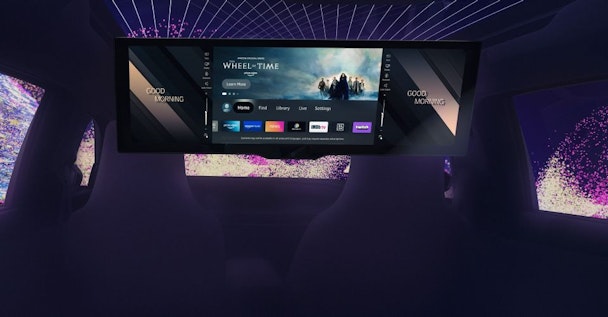Media Innovation Round-Up: in-car commerce, avatar evolution & livestreaming matures
Marek Wrobel vigilantly tracks emerging media tech for Havas Media Group. For The Drum, in the Media Innovation Round-Up, Wrobel explores ‘new and shiny’ tech and its role in the ever-evolving marketing mix.

New cars are being equipped with massive screens, such as the 31-inch screen announced by BMW
Shut up and drive... and shop
Ford has signed a deal with online payment processor Stripe aimed at bolstering the auto giant’s e-commerce strategy. This is a clear sign that yet another type of commerce is picking up steam – in-car commerce.
There are currently loads of fascinating shifts happening in the automotive space. Nowadays cars have computing power comparable to 20 personal computers. And they will only become more connected, with Gartner predicting cars as representing the majority (53%) of the 5G internet of things (IoT) market by next year. Maybe you will be connected to 5G through your car sooner than by your phone.
Accenture has stated that “cars no longer just get us from point A to B [...] the time is right to upscale ambitions for what the future in-car experience can and should be,” and has gone as far as calling our vehicles “experience platforms.”
These new experiences will be enabled by different technologies – massive screens that new cars are being equipped with (such as the 31-inch screen announced by BMW), app ecosystems, virtual reality (VR) entertainment platforms similar to the Audi and Disney partnership, digital radios and voice technology.
And all of these will create new opportunities for brands. Marketers will be able to create new types of media experiences, drive commerce and even measure effectiveness (General Motors partnered with Taco Bell to measure the impact of in-car radio advertising on visiting the QSR).
Radio and out-of-home (OOH) is no longer the only way to reach drivers and passengers. When it comes to turning the car into a potential media touchpoint, the marketer’s arsenal has got much bigger and even more exciting.
Show me your avatar and I’ll show you mine
Snap is hosting a virtual Bitmoji concert to promote the movie Marry Me. The virtual event will enable fans to log in via Snapchat, with their Bitmoji character then added to the crowd, and to take part in an interactive experience. It’s clearer than ever that avatars will be a key building block in creating more immersive virtual experiences.
I have mentioned the rise of avatar marketing on multiple occasions. Avatars will definitely be an important part of the puzzle as they are manifestations of the user, and they create our presence in virtual environments. Plus, we are really seeing the beginning of the avatar wars:
-
Snap continues to invest in Bitmojis, with the ‘Marry Me’ event being its first foray into more interactive activity.
-
Microsoft launched avatars for Teams a few months ago.
-
Startup Ready Player Me continues to thrive and announced a new round of investment.
-
In the last few days, Meta has announced 3D avatars that will be consistent across its apps.
-
TikTok started experimenting with 3D video avatars as well.
You can see three main trends in the avatar space. First of all, companies are embracing 3D avatars. Secondly, we are also seeing the shift to making avatars cross-platform (at least to some degree) – having the same avatar for more than just one app or game. This is something that is a unique selling proposition (USP) of Ready Player Me, but as you can see Meta has done something similar (although within its walled garden).
Last but not least, avatars are officially evolving beyond just gaming, with both social media and productivity tools embracing them as well. All of these mean there’s an even stronger case for brands to dip their toes into avatar marketing.
The rise and rise of augmented reality (AR) shopping has meant that Snapchat, Pinterest and Shopify have all announced new AR shopping features. Are we OK to agree AR shopping is now part of the mainstream?
While Snap is perhaps a usual suspect when it comes to AR shopping, it’s not the only player. In the last couple of weeks alone both Pinterest and Shopify have made announcements about new AR features. Pinterest has introduced a new home décor AR feature. And Shopify made it possible for merchants to add 3D and AR visualizations for their products. What makes it even more powerful for me is the fact that this is not just test-and-learn – this is a part of a long-standing AR shopping strategy.
Getting there
M&S has launched Live Shopping on M&S.com. Customers can join a live broadcast hosted by an M&S expert, ask questions, view product demonstrations and buy the products. Is this a sign of livestreaming finally maturing in the UK?
It seems that livestreaming is on a world tour that started in China, then moved to the US and is now arriving in Europe. Based on the WARC Marketer’s Toolkit survey 2022, 61% of marketers plan to increase their investment in livestreaming. Brands’ interest is driven by the fact that, according to McKinsey, livestreaming can both accelerate conversion and improve brand appeal and differentiation.
We’ve seen some experiments with livestreaming in the UK, however these were focused on social platforms – e.g. TikTok’s shopping experience – or partnering with livestreaming platforms, such as JD Sport’s partnership with OOOOO last year. However, what has been missing is brands creating livestreaming solutions within their owned ecosystem.
That is why I believe M&S launching livestreaming on its own website is a sign that the space is maturing, and we’ll see more doing it on owned channels.
